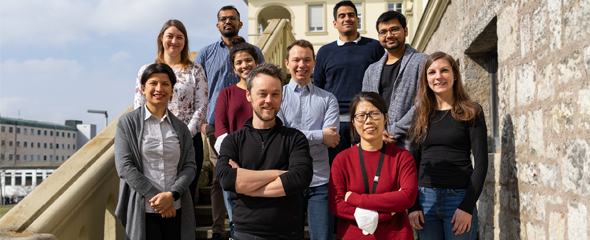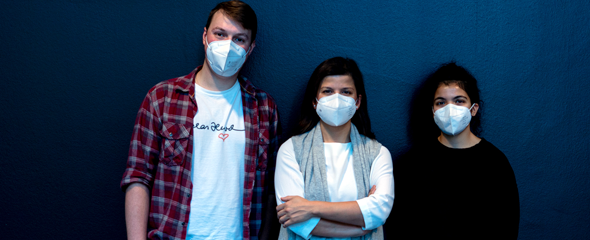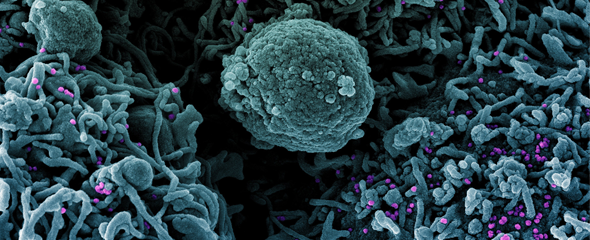

Our Research
The central focus of my group is to identify the molecular players and mechanisms of recoding events in viral pathogens and eukaryotic host cells by using biochemical and biophysical analysis tools. Frameshifting is a translational recoding event that is used by many important pathogens (i.e. HIV, SARS –CoV and MMTV) to synthesize central genes for replication and proliferation. Frameshifts also occur in prokaryotic and eukaryotic genomes with efficiencies reaching up to 80%. In most of the cases, a fixed ratio of frameshifting is crucial for the replication and proliferation of the viruses. There is also new compelling evidence suggesting temporal regulation of frameshifting by trans-acting small RNAs and proteins. However, we still lack the detailed understanding of the roles these alternative translation events play during cellular processes and pathogenesis and how they are regulated.
Our research focuses on these unconventional translation events in RNA viruses and cellular genes to understand the mechanistic details. By characterizing the RNA interaction network of pathogens and host cells we aim to shed light on the interaction of pathogenic processes and cellular responses. Additionally, to answer the role of specific frameshifting mRNA interactions, we use a highly interdisciplinary approach that combines cutting-edge RNA analytics, such as ribosome profiling and deep sequencing, with biochemical and computational tools. Our model systems include simplified reconstituted viral and cellular components to reveal the molecular phenomena in vitro as well as whole mammalian cells to study the cellular system in vivo.
Our Research
The central focus of my group is to identify the molecular players and mechanisms of recoding events in viral pathogens and eukaryotic host cells by using biochemical and biophysical analysis tools. Frameshifting is a translational recoding event that is used by many important pathogens (i.e. HIV, SARS –CoV and MMTV) to synthesize central genes for replication and proliferation. Frameshifts also occur in prokaryotic and eukaryotic genomes with efficiencies reaching up to 80%. In most of the cases, a fixed ratio of frameshifting is crucial for the replication and proliferation of the viruses. There is also new compelling evidence suggesting temporal regulation of frameshifting by trans-acting small RNAs and proteins. However, we still lack the detailed understanding of the roles these alternative translation events play during cellular processes and pathogenesis and how they are regulated.
Our research focuses on these unconventional translation events in RNA viruses and cellular genes to understand the mechanistic details. By characterizing the RNA interaction network of pathogens and host cells we aim to shed light on the interaction of pathogenic processes and cellular responses. Additionally, to answer the role of specific frameshifting mRNA interactions, we use a highly interdisciplinary approach that combines cutting-edge RNA analytics, such as ribosome profiling and deep sequencing, with biochemical and computational tools. Our model systems include simplified reconstituted viral and cellular components to reveal the molecular phenomena in vitro as well as whole mammalian cells to study the cellular system in vivo.
Jun Prof Dr Neva Caliskan
Understanding the mechanisms of RNA recoding during infections will give us new insights into translational regulation, which might be beneficial for developing novel gene therapies in future.

Neva Caliskan studied molecular biology and genetics at the Middle East Technical University in Ankara (Turkey) and worked as a visiting scholar in 2005 at EMBL in Heidelberg. She received her Master's degree at the International Max Planck Research School for Molecular Biology (Göttingen) in 2009. After completing her PhD in 2013, she first worked as a postdoctoral fellow at the Department of Physical Biochemistry at the Max Planck Institute for Biophysical Chemistry and then as a project leader at the same institute from 2015-2017. Since January 2018 she has been heading the junior research group "Recoding Mechanisms in Infections" at the Helmholtz Institute for RNA-based Infection Research (HIRI) in Würzburg. As of May 2018 she holds a junior professorship at the Faculty of Medicine of the University of Würzburg.
Selected Publications
Bock L.*, Caliskan N.*, Korniy N., Peske F., Rodnina MV. and Grubmueller H. (2019). Thermodynamic control of –1 programmed ribosomal frameshifting, Nature Communications, in press. (*co-first authors)
Matsumoto S., Caliskan N., Rodnina M. V., Murata A., and Nakatani K. (2018). Small synthetic molecule as an activator for −1 ribosomal frameshifting, Nucleic Acid Research, 46(16): 8079-8089
Caliskan N, Wohlgemuth I, Korniy N, Pearson M, Peske F, Rodnina MV Conditional Switch between Frameshifting Regimes upon Translation of dnaX mRNA Mol Cell 2017, 66(4): 558-567
Belardinelli R., Sharma H., Caliskan N., Peske F., Wintermeyer W. and Rodnina M. V. (2016). Choreography of molecular movements during ribosome progression along the mRNA. Nature Structural and Molecular Biology, 23(4):342-8
Caliskan N, Peske F, Rodnina MV Changed in translation: mRNA recoding by -1 programmed ribosomal frameshifting Trends Biochem Sci 2015, 40(5): 265-274
Caliskan N, Katunin VI, Belardinelli R, Peske F, Rodnina MV Programmed -1 frameshifting by kinetic partitioning during impeded translocation Cell 2014, 157(7): 1619-1631








